牛津高中英语M3U3 period3导学案
- 格式:doc
- 大小:115.00 KB
- 文档页数:5
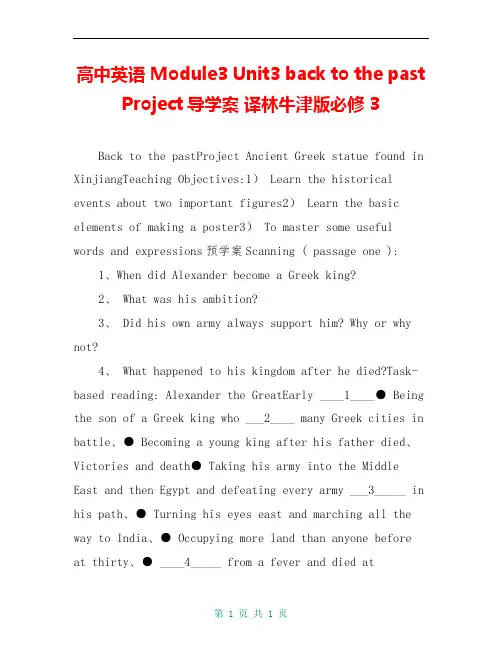
高中英语 Module3 Unit3 back to the past Project导学案译林牛津版必修3Back to the pastProject Ancient Greek statue found in XinjiangTeaching Objectives:1) Learn the historical events about two important figures2) Learn the basic elements of making a poster3) To master some useful words and expressions预学案Scanning ( passage one ):1、When did Alexander become a Greek king?2、 What was his ambition?3、 Did his own army always support him? Why or why not?4、 What happened to his kingdom after he died?Task-based reading: Ale xander the GreatEarly ____1____● Being the son of a Greek king who ___2____ many Greek cities in battle、● Becoming a young king after his father died、Victories and death● Taking his army into the Middle East and then Egypt and defeating every army ___3_____ in his path、● Turning his eyes east and marching all the way to India、● Occupying more land than anyone before at thirty、● ____4_____ from a fever and died at33、Influence on the worldSpreading the Greek culture from Europe to Africa and Asia, which has a great____5_____ on the world for centuries to come、探究案Language points:1、When asked how a statue from distant Greece could have appeared in China, researchers explained that no doubt this was a result of Alexander the Great’ s influence、当被问及来自遥远希腊的塑像怎么会出现在中国时,研究人员解释说,这无疑是亚历山大大帝的影响所致。
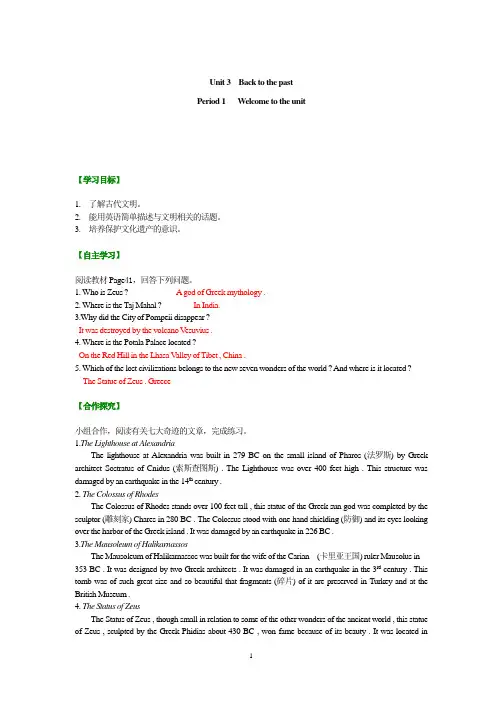
Unit 3 Back to the pastPeriod 1 Welcome to the unit【学习目标】1. 了解古代文明。
2. 能用英语简单描述与文明相关的话题。
3. 培养保护文化遗产的意识。
【自主学习】阅读教材Page41,回答下列问题。
1. Who is Zeus ? A god of Greek mythology .2. Where is the Taj Mahal ? In India.3.Why did the City of Pompeii disappear ?It was destroyed by the volcano V esuvius .4. Where is the Potala Palace located ?On the Red Hill in the Lhasa V alley of Tibet , China .5. Which of the lost civilizations belongs to the new seven wonders of the world ? And where is it located ? The Statue of Zeus . Greece【合作探究】小组合作,阅读有关七大奇迹的文章,完成练习。
1.The Lighthouse at AlexandriaThe lighthouse at Alexandria was built in 279 BC on the small island of Pharos (法罗斯) by Greek architect Sostratus of Cnidus (索斯查图斯) . The Lighthouse was over 400 feet high . This structure was damaged by an earthquake in the 14th century .2. The Colossus of RhodesThe Colossus of Rhodes stands over 100 feet tall , this statue of the Greek sun god was completed by the sculptor (雕刻家) Chares in 280 BC . The Colossus stood with one hand shielding (防御) and its eyes looking over the harbor of the Greek island . It was damaged by an earthquake in 226 BC .3.The Mausoleum of HalikarnassosThe Mausoleum of Halikarnassos was built for the wife of the Carian (卡里亚王国) ruler Mausolus in 353 BC . It was designed by two Greek architects . It was damaged in an earthquake in the 3rd century . This tomb was of such great size and so beautiful that fragments (碎片) of it are preserved in Turkey and at the British Museum .4. The Status of ZeusThe Status of Zeus , though small in relation to some of the other wonders of the ancient world , this statue of Zeus , sculpted by the Greek Phidias about 430 BC , won fame because of its beauty . It was located inOlympia , Greece . It was damaged in a big fire in 462 AD .5.The T emple of ArtemisThe Temple of Artemis was a Greek temple built in Ephesus and dedicated to ( 以庄严地形式奉献给) the Greek goddess Artemis (Diana) , the maiden goddess of hunting . It is said that the temple reached its standing as a wonder , because it was the most beautiful structure ever built . In 356 BC the temple was burnt to the ground .6.The Hanging Gardens of BabylonThe Hanging Gardens of Babylon might be built around 600 BC by Babylonian King Nebuchadnezzar II for his wife . Many Greek historians of the ancient world mentioned these gardens in their works . Around the second century BC the splendid walls and gardens were destroyed by earthquakes .7.The Great Pyramids at GizaThe Great Pyramids at Giza , which date from the old Kingdom (2700—2300 BC) are the oldest and most famous of the Seven W onders of the world . Y et it is the only surviving of the Seven Ancient W onders .I . 小组合作翻译七大奇迹。
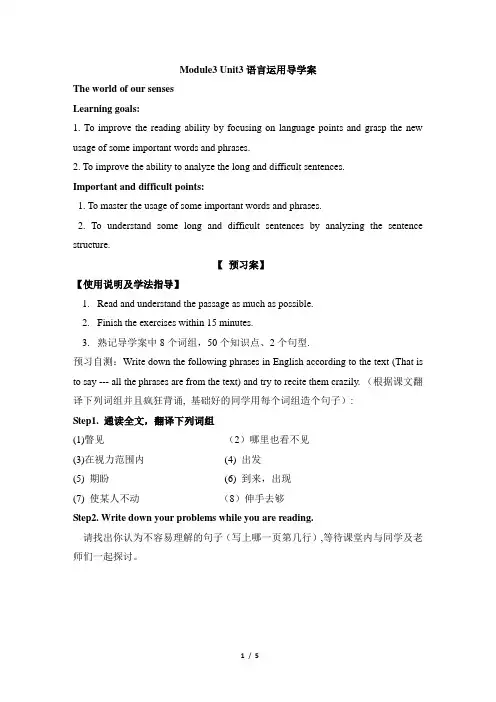
Module3 Unit3语言运用导学案The world of our sensesLearning goals:1. To improve the reading ability by focusing on language points and grasp the new usage of some important words and phrases.2. To improve the ability to analyze the long and difficult sentences.Important and difficult points:1. To master the usage of some important words and phrases.2. To understand some long and difficult sentences by analyzing the sentence structure.【预习案】【使用说明及学法指导】1.Read and understand the passage as much as possible.2.Finish the exercises within 15 minutes.3.熟记导学案中8个词组,50个知识点、2个句型.预习自测:Write down the following phrases in English according to the text (That is to say --- all the phrases are from the text) and try to recite them crazily. (根据课文翻译下列词组并且疯狂背诵, 基础好的同学用每个词组造个句子):Step1. 通读全文,翻译下列词组(1)瞥见______________________ (2)哪里也看不见_________________ (3)在视力范围内______________ (4) 出发_________________________(5) 期盼_____________________ (6) 到来,出现___________________(7) 使某人不动_______________ (8)伸手去够____________________Step2. Write down your problems while you are reading.请找出你认为不容易理解的句子(写上哪一页第几行),等待课堂内与同学及老师们一起探讨。
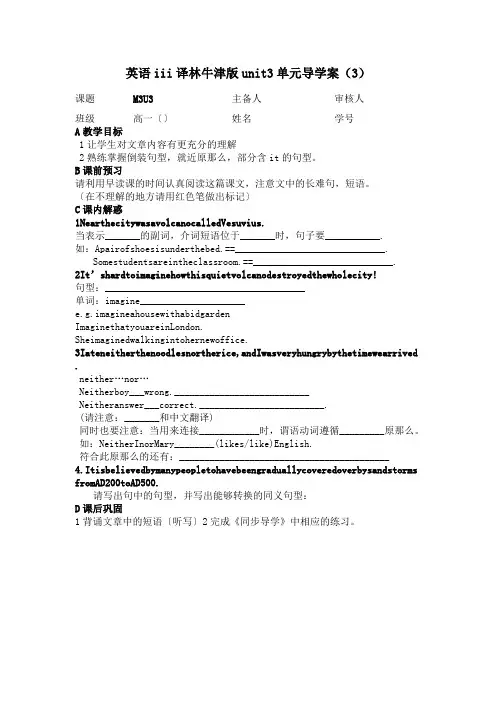
英语iii译林牛津版unit3单元导学案(3)课题M3U3 主备人审核人班级高一〔〕姓名学号A教学目标1让学生对文章内容有更充分的理解2熟练掌握倒装句型,就近原那么,部分含it的句型。
B课前预习请利用早读课的时间认真阅读这篇课文,注意文中的长难句,短语。
〔在不理解的地方请用红色笔做出标记〕C课内解惑1NearthecitywasavolcanocalledVesuvius.当表示_______的副词,介词短语位于_______时,句子要___________.如:Apairofshoesisunderthebed.==______________________________.Somestudentsareintheclassroom.==____________________________.2It’shardtoimaginehowthisquietvolcanodestroyedthewholecity!句型:________________________________________单词:imagine_____________________e.g.imagineahousewithabidgardenImaginethatyouareinLondon.Sheimaginedwalkingintohernewoffice.3Iateneitherthenoodlesnortherice,andIwasveryhungrybythetimewearrived .neither…nor…Neitherboy___wrong.___________________________Neitheranswer___correct._________________________.(请注意:_______和中文翻译)同时也要注意:当用来连接____________时,谓语动词遵循_________原那么。
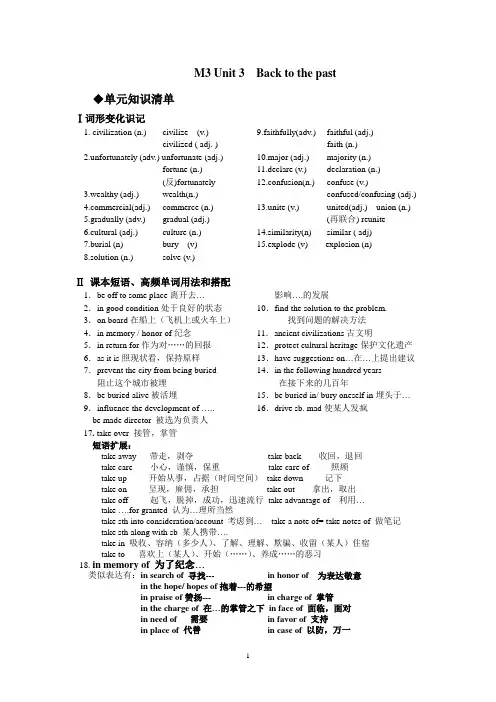
M3 Unit 3 Back to the past◆单元知识清单Ⅰ词形变化识记1. civilization (n.) civilize (v.)civilized ( adj. ) 2.unfortunately (adv.) unfortunate (adj.)fortune (n.)(反)fortunately3.wealthy (adj.) wealth(n.)mercial(adj.) commerce (n.)5.gradually (adv.) gradual (adj.)6.cultural (adj.) culture (n.)7.burial (n) bury (v)8.solution (n.) solve (v.) 9.faithfully(adv.) faithful (adj.)faith (n.)10.major (adj.) majority (n.)11.declare (v.) declaration (n.)12.confusion(n.) confuse (v.)confused/confusing (adj.)13.unite (v.) united(adj.) union (n.)(再联合) reunite14.similarity(n) similar ( adj)15.explode (v) explosion (n)Ⅱ课本短语、高频单词用法和搭配1.be off to some place离开去…2.in good condition处于良好的状态3.on board在船上(飞机上或火车上)4.in memory / honor of纪念5.in return for作为对……的回报6.as it is照现状看,保持原样7.prevent the city from being buried 阻止这个城市被埋8.be buried alive被活埋9.influence the development of …..影响….的发展10.find the solution to the problem.找到问题的解决方法11.ancient civilizations古文明12.protect cultural heritage保护文化遗产13.have suggestions on…在…上提出建议14.in the following hundred years在接下来的几百年15.be buried in/ bury oneself in埋头于…16.drive sb. mad使某人发疯be made director 被选为负责人17. take over 接管,掌管短语扩展:take away 带走,剥夺take back 收回,退回take care 小心,谨慎,保重take care of 照顾take up 开始从事,占据(时间空间)take down 记下take on 呈现,雇佣,承担take out 拿出,取出take off 起飞,脱掉,成功,迅速流行take advantage of 利用…take ….for granted 认为…理所当然take sth into consideration/account 考虑到…take a note of= take notes of 做笔记take sth along with sb 某人携带….take in 吸收、容纳(多少人)、了解、理解、欺骗、收留(某人)住宿take to 喜欢上(某人)、开始(……)、养成……的恶习18. in memory of 为了纪念…类似表达有:in search of 寻找--- in honor of 为表达敬意in the hope/ hopes of抱着---的希望in praise of赞扬--- in charge of 掌管in the charge of 在…的掌管之下in face of 面临,面对in need of 需要in favor of 支持in place of 代替in case of 以防,万一in the form of以…的形式in times of 在…时期19. remainMuch remained to be settled.还有很多有待解决。
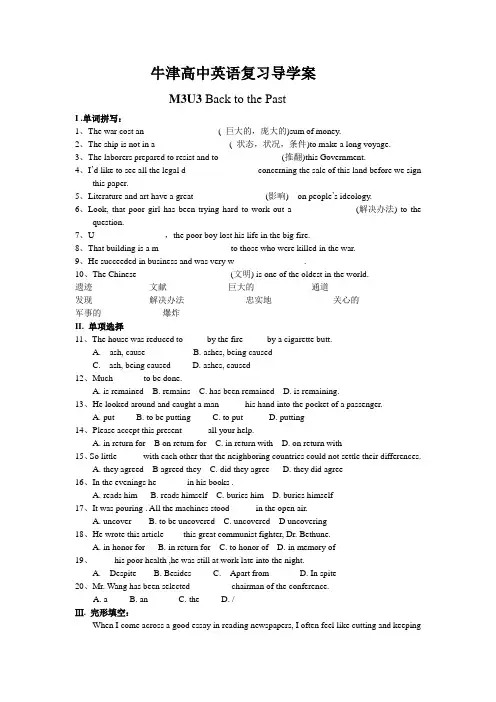
牛津高中英语复习导学案M3U3 Back to the PastI .单词拼写:1、The war cost an _______________( 巨大的,庞大的)sum of money.2、The ship is not in a _______________( 状态,状况,条件)to make a long voyage.3、The laborers prepared to resist and to ______________(推翻)this Government.4、I’d like to see all the legal d________________ concerning the sale of this land before we signthis paper.5、Literature and art have a great ________________(影响)on people’s ideology.6、Look, that poor girl has been trying hard to work out a ______________(解决办法) to thequestion.7、U________________,the poor boy lost his life in the big fire.8、That building is a m________________ to those who were killed in the war.9、He succeeded in business and was very w________________.10、The Chinese ___________________ (文明) is one of the oldest in the world.遗迹__________ 文献___________ 巨大的__________ 通道___________发现__________ 解决办法___________ 忠实地___________ 关心的__________军事的___________ 爆炸__________II. 单项选择11、The house was reduced to _____by the fire _____by a cigarette butt.A. ash, causeB. ashes, being causedC. ash, being causedD. ashes, caused12、Much ______ to be done.A. is remainedB. remainsC. has been remainedD. is remaining.13、He looked around and caught a man _____ his hand into the pocket of a passenger.A. putB. to be puttingC. to putD. putting14、Please accept this present _____ all your help.A. in return for B on return for C. in return with D. on return with15、So little _____ with each other that the neighboring countries could not settle their differences.A. they agreed B agreed they C. did they agree D. they did agree16、In the evenings he ______ in his books .A. reads himB. reads himselfC. buries himD. buries himself17、It was pouring . All the machines stood _____ in the open air.A. uncoverB. to be uncoveredC. uncovered D uncovering18、He wrote this article ____this great communist fighter, Dr. Bethune.A. in honor forB. in return forC. to honor ofD. in memory of19、_____his poor health ,he was still at work late into the night.A. DespiteB. BesidesC. Apart fromD. In spite20、Mr. Wang has been selected_________ chairman of the conference.A. aB. anC. theD. /Ⅲ. 完形填空:When I come across a good essay in reading newspapers, I often feel like cutting and keepingit. But just as I am about to do so I find the article on the 1___ side is as much interesting. It may be a discussion of the way to keep in good health, or advice about how to be oneself in 2___ . If I cut the front essay, the opposite one is bound to 3___ damage, leaving out half of it or keeping the text without the subject. As a result, the scissors would 4___ before they start, or halfway done when I find out the result that inevitably cause me 5___.Sometimes two things are to be done at the same time, both worthy your 6___. You can only take up one of them, while the other has to wait or be 7___. But you know the future is unpredictable ---- the changed 8___ may not allow you to do what is 9___ behind. Thus you are caught in a fix and feel sad. 10 ___come that nice opportunities and brilliant ideas should gather around all at once? It may 11___ that your life changes dramatically on your preference of one 12___ to the other.In fact that is what life is like: we are often 13___ with the two opposite sides of a thing which are both desirable like newspaper cutting. It often 14___ that our attention is drawn to one thing only after we take up another. The former may be more 15___ than the latter and give rise to a divided 16___ . I still remember a philosopher’s remarks, “When one door shuts, another opens in life.”17___ a passive choice may not be a bad one.Whatever we do in our lifetime, wherever life’s storm makes us 18 ___, there must be something we can 19___ , some shore we can land on. Don’t forget God always keeps an alternative door open for every one. While the front door is closed, there must be another 20___ for you.1. A. other B. opposite C. back D. front2.A. society B. your business C. relation D. the word3. A. suffer B. cause C. receive D. serve4. A. fix B. turn C. stay D. close5. A. fault B. regret C. disappointment D. trouble6. A. thought B. sense C. purpose D. attention7. A. put away B. given up C. let out D. held on8. A. chance B. situation C. state D. condition9.A. done B. counted C. prepared D. left10.A. How B. Why C. Where D. When11. A. seem B. happen C. develop D. show12.A. decision B. opinion C. choice D. result13.A. faced B. mixed C. provided D. offered14.A.appears B. occurs C. proves D. explains15.A. necessary B. exciting C. important D. valuable16.A. mind B. subject C. soul D. brain17.A. But B. Otherwise C. And D. So18.A. stop B. live C. pull D. go19.A. depend B. treasure C. achieve D. imagine20.A. alive B. open C. familiar D. suitableⅣ阅读理解:AProfessor Reason recently persuaded 35 people to keep a diary of all their absent-minded actions for two weeks. When he came to analyze(分析) their embarrassing errors , he was surprised to find that nearly all of them fell into a few groups .One of the women, for instance, on leaving her house for work one morning threw her pet dog her ear-rings and tried to fix a dog biscuit on her ear. “ The explanation for this is that the brain is like a computer, ” explains the professor, “ People progra mme themselves to do certain activities regularly. It was the woman’s custom every morning to throw her dog two biscuits and then put on her ear-rings. But somehow the action got reversed(颠倒) in the programme .”About one in twenty of the incidents the vol unteers reported were these “ programme assembly failures.”Twenty per cent of all errors were “ test failures ”—primarily due to not verifying the progress of what the body was doing . A man about to get his car out of the garage passed through the back yard where his garden jacket and boots were kept , put them on —much to his surprise . A woman victim reported : “ I got into the bath with my socks on .”The commonest problem was information “ storage failures”. People forgot the names of people whose faces they knew, went into a room and forgot why they were there, mislaid something, or smoked a cigarette without realizing it.The research so far suggests that while the “ central processor” of the brain is liberated from second-to-second control of a well-practiced routine, it must repeatedly switch back its attention at important decision points to check that the action goes on as intended. Otherwise the activity may be “ captured ” by another frequently and recently used programme, resulting in embarrassing errors.1. The purpose of Professor Reason’s research is.A. to show the difference between men and women in their reasoningB. to classify and explain some errors in human actionsC. to find the causes which lead to computer failuresD. to compare computer functions with brain workings .2. Whic h of the following might be grouped under “ programme assembly failures ”?A. A woman went into a shop and forgot what to buy.B. A man returning home after work left his key in the lock.C. A lady fell as she was concentrating on each step her feet were taking.D. An old man, with his shoes on, was trying to put on his socks.3. The word “ verifying ” in paragraph 3 can be replaced by .A. improvingB. changingC. checkingD. stopping4. According to the passage, the information “ storage failures ” refer to .A. the destruction of information collecting systemB. the elimination of one’s total memoryC. the temporary loss of part of one’s memoryD. the separation of one’s action from consciousnessI.书面表达假定你们班由同学们捐赠建起了一个小图书馆,为了更好地利用它,让它有助于同学们学习英语和其它各个学科,你作为班长,向全班宣布从明天开始可以借书. 另外,你规定:1. 每次只能借一本;2. 每本只能借一周,要及时归还;3. 要爱惜书,不得转借他人。
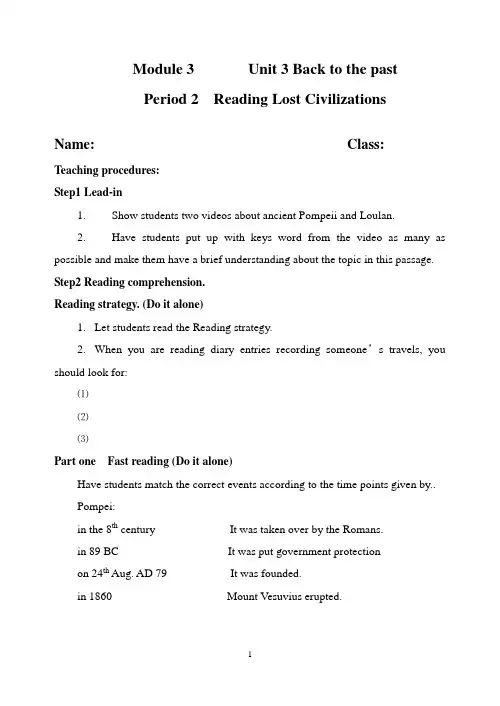
Module 3 Unit 3 Back to the pastPeriod 2 Reading Lost CivilizationsName: Class:Teaching procedures:Step1Lead-in1.Show students two videos about ancient Pompeii and Loulan.2.Have students put up with keys word from the video as many as possible and make them have a brief understanding about the topic in this passage. Step2 Reading comprehension.Reading strategy. (Do it alone)1.Let students read the Reading strategy.2.When you are reading diary entries recording someone’s travels, you should look for:⑴⑵⑶Part one Fast reading (Do it alone)Have students match the correct events according to the time points given by..Pompei:in the 8th century It was taken over by the Romans.in 89 BC It was put government protectionon 24th Aug. AD 79 It was founded.in 1860 Mount Vesuvius erupted.Loulan2000 years ago It was discovered by a Swedish explorer.from AD 200 to AD 500 It existed as a commercial city.100 years ago It was covered over gradually by sand-storms.Part two Further readingExercise one(Do it alone)1,From the passage, we can learn that ______.A. Ann traveled many places in eleven days.B. Pompeii had been a rich city before the Romans took over it.C. Pompeii and Loulan were both discovered in the 18th century.D. some houses in Pompeii were decorated with wall paintings.2. Which of the following is True ? ______A. Sven Hedin was an English archaeologist.B. Loulan was once a small, wealthy commercial city.C. Now a volcano called Vesuvius has disappeared.D. All the people fled from Pompeii before Vesuvius erupted.3. Why was Loulan an important city about 2,000 years ago?A. Because it was a stopping point on the famous Silk Road between the East and the West.B. Because it once a big, rich commercial city with lots of treasures.C. Because there was an ancient water system that ran through the middle of the city.D. Because people have discovered many palaces, temples, workshops and towers in the city.4. The purpose of the passage is to ______.A. tell us a travel experience in Pompeii and Loulan.B. offer us some information about ancient civilizations.C. introduce a cultural expedition to two sites of lost civilizations.D. All of aboveExercise two 语法填空( Cooperative learning)Both Pompeii in Italy and Loulan in China became lost civilizations about 2000 years ago. Pompeii_____(find) in the 8th century BC and was taken over by the Romans in 89BC. ___ 24th Aug.AD79, Mount Vesuvius ___(erupt) and the city were buried ___(live). Loulan was____stopping point on the Silk Road. __ disappeared under the storm. There are just a few _____(ruin) left. Some treasures, such as coins _____ painted pots, was found. ______ the two ancient cities disappeared ______(real) made people regretful..Step 4 Discussion. (Group work)Do you think it important to protect cultural heritage(遗产)?Give your suggestions.Step 5Summary&Homework.SummaryIn this section ,we have learnt the strategy of reading diary entries,such as, dates ,place names and opinions...On the other side, we have a basic understanding for lost civilizations,especially for the brief history of ancient Pompeii and Loulan. We also made some suggestions on how to treat the cultural heritages.Cultural heritages are people's precious wealth, we should try our best to protect them from damaging.Homework:1.Try translating the five diary entries by yourself.2.Finish the exercises of C2 and D1 on page 44.。
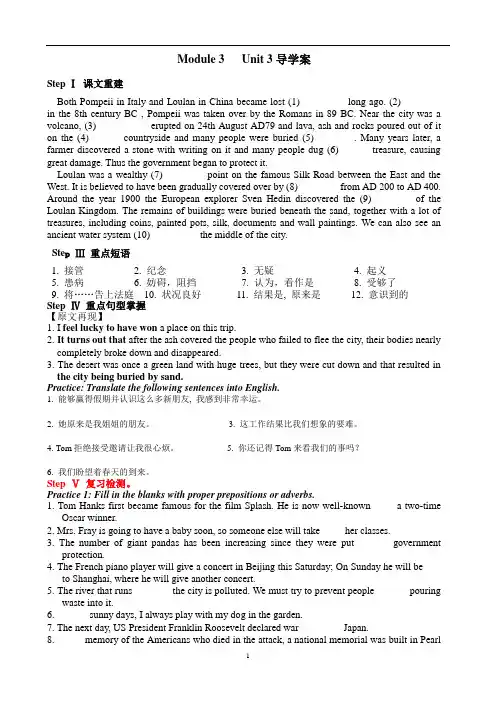
Module 3 Unit 3导学案Step Ⅰ课文重建Both Pompeii in Italy and Loulan in China became lost (1)_________ long ago. (2)________ in the 8th century BC , Pompeii was taken over by the Romans in 89 BC. Near the city was a volcano, (3)___________erupted on 24th August AD79 and lava, ash and rocks poured out of it on the (4)_______countryside and many people were buried (5)________. Many years later, a farmer discovered a stone with writing on it and many people dug (6)______ treasure, causing great damage. Thus the government began to protect it.Loulan was a wealthy (7)_________point on the famous Silk Road between the East and the West. It is believed to have been gradually covered over by (8)________ from AD 200 to AD 400. Around the year 1900 the European explorer Sven Hedin discovered the (9)________ of the Loulan Kingdom. The remains of buildings were buried beneath the sand, together with a lot of treasures, including coins, painted pots, silk, documents and wall paintings. We can also see an ancient water system (10) _________ the middle of the city.Ste p Ⅲ重点短语1. 接管2. 纪念3. 无疑4. 起义5. 患病6. 妨碍,阻挡7. 认为,看作是8. 受够了9. 将……告上法庭10. 状况良好11. 结果是, 原来是12. 意识到的StepⅣ重点句型掌握【原文再现】1. I feel lucky to have won a place on this trip.2. It turns out that after the ash covered the people who failed to flee the city, their bodies nearly completely broke down and disappeared.3. The desert was once a green land with huge trees, but they were cut down and that resulted in the city being buried by sand.Practice: Translate the following sentences into English.1. 能够赢得假期并认识这么多新朋友, 我感到非常幸运。
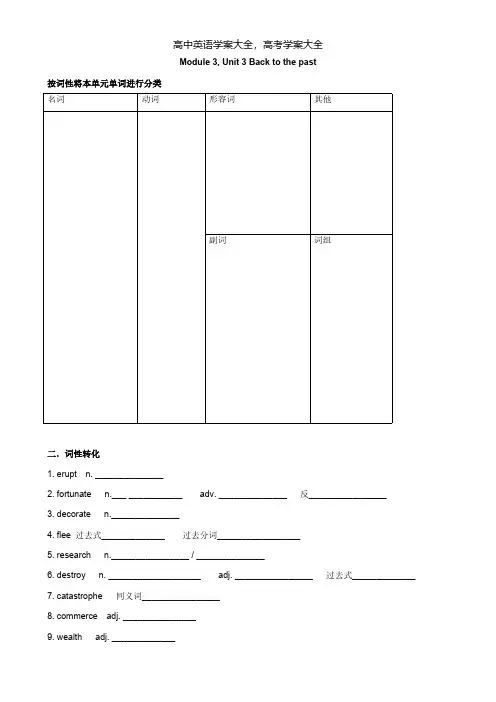
Module 3, Unit 3 Back to the past按词性将本单元单词进行分类名词动词形容词其他副词词组二.词性转化1. erupt n. ______________2. fortunate n.___ ___________ adv. ______________ 反________________3. decorate n.______________4. flee 过去式_____________ 过去分词_________________5. research n.________________ / ______________6. destroy n. ___________________ adj. ________________ 过去式_____________7. catastrophe 同义词________________8. commerce adj. _______________9. wealth adj. _____________10. gradual adv. _______________11. culture adj. ________________12. ruin n. _____________13. remain n. ______________ adj. ____________________14. explode n. ______________15. extreme adv. _______________16. complain n. ________________17. wood adj. _____________ wool adj. _______________18. history adj. _______________ / ___________________ n. 历史学家______________19. solve n. ______________20. express n. _______________21. power adj. ________________22. sail n. ____________23. declare n. _________________24. memory adj. ______________ / _________________ v. _____________25. educate n. _________________ / _______________26. aware n. _________________27. base n. ___________28. corrupt adj. ______________ n. _________________29. judge n.(法官)____________ (判断)_______ ___________30. poison adj. _________________ v. ______________31. material adj. ____________三.助学性短语①词汇的拓展1.the company founded in 1999 (establish, set up)2.take in 收留;吸入;领会;欺骗take over夺取;接管take off 脱下;起飞;事业腾飞take on 呈现;雇佣;承担take up 开始从事;占据;着手处理take after 相似,想象take to喜欢;开始从事;形成…习惯3.pour in 流入;灌入;源源不断pour down 倾盆大雨4.decorate …with …mercial advertisements6.be in ruinsbe reduced to ruinsruin the hope / holiday / health / crops / chance7.remain to be done/seen/solvedremain seated=sitting/ unsolved/ unfinished/unknownremain poor/ hot/ mysteriousremain a teacher/ a puzzle/ a problemremaining money = money leftthe remains of the dinnerhuman remains8.the village nearly= the nearby village9.It’s beneath one’s dignity to do sth.plain sth to sb. complain to sb. sth11.the solution to (doing ) sth.the key /approach to doing sth.12.the puzzled expression/ lookbeyond expression facial expressionexpress oneselftravel by express13.declare war on/ against14.in memory of / in honor ofkeep/bear sth in memory/ mind = memorizecate sb. to doa well-educated lady16. no doubtno wonder17.stand in one’s path/ way18.rise up againste down with a feverfall ill with a fever20.be aware of /thatbe conscious ofmake sb. aware ofraise one’s awareness of environmental protection21.on trial在受审中,在试验中trial and error反复试验Life is full of little trials.22.take sb. to court23.Judging from/by24.a corrupt official②课文的漫步1.attend a lecture2.be buried alive3.put…under government protection4.on rainy days5.It turns out that/ to be/ as planned6.fail to flee the city7.break down break up break out break in break away8.be believed(said/reported) to do/ to have done/ to be doing9.resulted in/lead to the city being buried by sandcause the city to be buried by sand10.be in good condition11.prepare sb to do12.be of great cultural value13.preserve historical buildings/sites14.do research on/into15.defeat sb16.centuries to come17.grow/ be tired of18.be thought of asview/ regard /consider/look on…as19.aside /apart from20.question the existence of21.have enough of him22.make a bad situation worse四. 单元重点句子及拓展1. Next week we are flying to china, and going to Loulan, which is known as China’s Pompeii in the desert.2. Many people were buried alive, and so was the city.3. Today I saw the ancient Roman city of Pompeii as it was 2,000 years ago.4. It’s hard to imagine how this peaceful volcano destroyed the whole city.5. Sven found the remains of buildings buried beneath the sand, together with a lot of treasures.与课文单词有关的谚语1. the pot calling the kettle black 锅笑壶黑, 五十步笑百步2. judge a book by its cover = judge people by outward appearance 以貌取人3. It never rains but it pours. 要么不下雨,要么就下大雨/不鸣则已一鸣惊人/一倒霉就步步倒霉,祸不单行4. All roads lead to Rome. 条条大路通罗马;殊途同归5. Rome was not built in a day 罗马城非一夕建成,伟业非一日之功6. When in Rome do as the Romans do. 入乡随俗,到什么山唱什么歌话题:是否应该花巨资来维护和保护文化遗址There are many historical sites in China. A heated discussion was held about whether it is necessary to maintain and protect them. But it’s well-known that the opinion concerning this hot topic varies from person to person.The majority of students think it's important to do so. In their view, to begin with, the historical sites are witnesses of the history of the city. What’s more, they so important that they can attract a number of travelers in or out of China to come and promote the development of local economy.Few of them, however, differ in their opinions on this matter. They consider they are too old. For one thing, it will cost too much money and time to maintain them. For another, they occupy too much room and they should be pulled down.Personally, it's of chief importance to protect them. Although they are old, once you tear them down you can never rebuilt them. They are the sign and monument of ancient Chinese culture.。
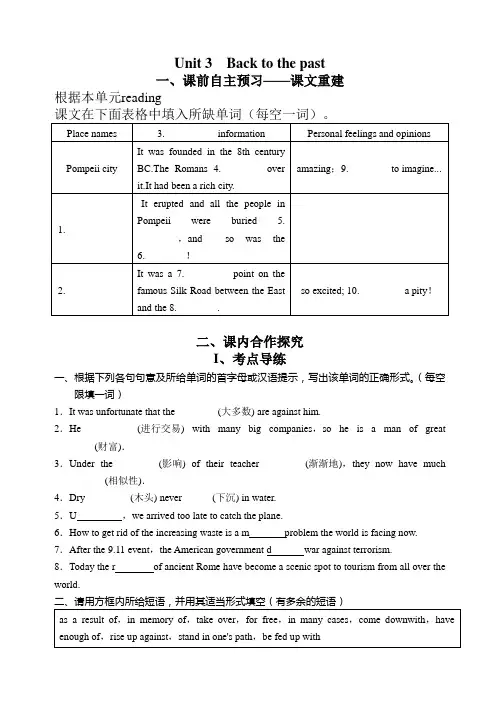
Unit 3 Back to the past一、课前自主预习——课文重建根据本单元reading二、课内合作探究I 、考点导练一、根据下列各句句意及所给单词的首字母或汉语提示,写出该单词的正确形式。
(每空限填一词)1.It was unfortunate that the ________(大多数) are against him.2.He ________ (进行交易) with many big companies ,so he is a man of great ________(财富).3.Under the ________(影响) of their teacher ________(渐渐地),they now have much ________(相似性).4.Dry ________ (木头) never______(下沉) in water.5.U_________,we arrived too late to catch the plane.6.How to get rid of the increasing waste is a m_______problem the world is facing now.7.After the 9.11 event ,the American government d______ war against terrorism.8.Today the r_______ of ancient Rome have become a scenic spot to tourism from all over the world.1.Jane ___________a cold and was absent from school yesterday.2.T-shirts in that shop are on sale now.You buy one and get another one _________. 3.Having worked in an office for many years,Uncle Li has ________sitting at a desk and has opened a small shop.4.I ____________Michael!He always plays music so loud that I can't study at all.5.Mike is running for chairman of the board.He is willing to do anything to defeat those who____________.6.During the Anti-Japanese War,many Chinese ___________their rulers.7.It is said that IBM ____________many small companies now.8.___________,people from Northern European countries have little difficulty communicating with each other.9.______________ thick fog,we put off our sports meeting.10.The monument was built _____________Qian Xuesen.三、汉译英。
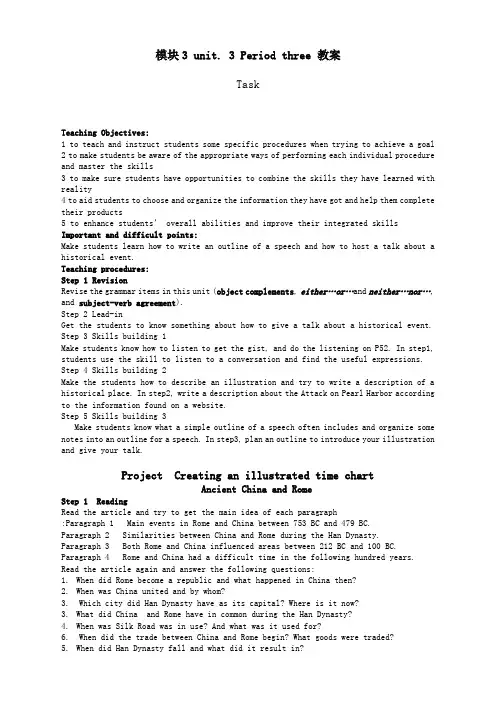
模块3 unit. 3 Period three 教案TaskTeaching Objectives:1 to teach and instruct students some specific procedures when trying to achieve a goal2 to make students be aware of the appropriate ways of performing each individual procedure and master the skills3 to make sure students have opportunities to combine the skills they have learned with reality4 to aid students to choose and organize the information they have got and help them complete their products5 to enhance students’ overall abilities and impr ove their integrated skills Important and difficult points:Make students learn how to write an outline of a speech and how to host a talk about a historical event.Teaching procedures:Step 1 RevisionRevise the grammar items in this unit (object complements, either…or…and neither…nor…, and subject-verb agreement).Step 2 Lead-inGet the students to know something about how to give a talk about a historical event. Step 3 Skills building 1Make students know how to listen to get the gist, and do the listening on P52. In step1, students use the skill to listen to a conversation and find the useful expressions. Step 4 Skills building 2Make the students how to describe an illustration and try to write a description of a historical place. In step2, write a description about the Attack on Pearl Harbor according to the information found on a website.Step 5 Skills building 3Make students know what a simple outline of a speech often includes and organize some notes into an outline for a speech. In step3, plan an outline to introduce your illustration and give your talk.Project Creating an illustrated time chartAncient China and RomeStep 1 ReadingRead the article and try to get the main idea of each paragraph:Paragraph 1 Main events in Rome and China between 753 BC and 479 BC.Paragraph 2 Similarities between China and Rome during the Han Dynasty.Paragraph 3 Both Rome and China influenced areas between 212 BC and 100 BC. Paragraph 4 Rome and China had a difficult time in the following hundred years. Read the article again and answer the following questions:1.When did Rome become a republic and what happened in China then?2.When was China united and by whom?3. Which city did Han Dynasty have as its capital? Where is it now?3.What did China and Rome have in common during the Han Dynasty?4.When was Silk Road was in use? And what was it used for?6. When did the trade between China and Rome begin? What goods were traded?5.When did Han Dynasty fall and what did it result in?8.When was Roman Empire ended? Was it the same story for China?Step 2 Language study1. In 753 BC, the city of Rome was founded, an d in 509, it became a republic.2. Fifteen years later the Qin dynasty was overthrown, and the Han Dynasty was founded with Chang’an as its capital city.重点讲解“With +宾语+ 宾补”的用法。
M3U3 Project 学案一.课前短语语积累:1) take place 发生= occursth. occurred to sb. 某人突然想起…2) all through time 一直以来all through history 有史以来3)play key roles in history 在历史中起重大作用/ 扮演重要角色play an important /active part(role) in …在……中起重要/ 积极作用4)get done 结构:get started 开始,启动get lost 迷路get separated 分开,分离get stolen 被偷二.课文注释:1. The metal statue is of a Greek soldier. (L.2)of a Greek soldier是介词短语,意为“属于……的”,在句中可作表语,也可作后置定语。
此句可改为:It is a metal statue of a Greek soldier. (后置定语)2. When asked how a statue from distant Greece could have appeared in China, …(L.2)在when, while, if , unless, though, once, as 等连词引导的状语从句中,若从句的主语和主句的主语相同,且从句谓语部分由be 动词,则从句的主语和be可以省略。
如:1) If you are given a chance, try to seize it.=If given a chance, try to seize it.2) When completed (complete), the museum will be open to the public next year.D 3) While building a Tunnel through the mountain, _______.A. an underground lake was discoveredB. there was an underground lake discoveredC. a lake was discovered undergroundD. the workers discovered an underground lakeD 4) –Will you go and attend her party?--No, ______ invited to.A. ifB. whenC. onceD. even if5) Once caught (catch) stealing in the exam, you will surely be punished.3. no doubt (that) …=There is no doubt that…There is no doubt about sth. 对……毫无疑问,确认而no wonder 难怪,不足为奇B --He is always hardworking and raises as many questions as possible after class.-- ______ he has made so much progress.A. No doubtB. No wonderC. No problemD. No waydoubt vt. 怀疑:肯定句中接whether / if否定句中接that翻译:1) 我肯定他会成功的。
Unit 3 Back to the Past Project 导学案Teaching aims:1. Read and understand the text.2. Get to know how to introduce someone important in history.Teaching procedures:Step 1 Lead inThe teacher starts the lesson by showing a picture of the film Alexander,and thus introduce the article students are going to read.Step 2 Read and understand1. Ask students to listen to the tape recording of the text and read the text.2. Help students get the main idea of each paragraph.3. Ask students to read the text again and answer the questions to make sure they understand the text.4. Ask students to read the article and answer the questions.Step 3 Language points(1) words(2) phrases1. 击败每一只军队2. 阻碍了他3. 长驱直入印度4. 阻止他控制这个世界5. 对无休止的战斗厌烦6. 拒绝再往前走7. 在他前面[来源:]8. 发烧病倒(3) Sentences1. Alexander the Great spread the Greek culture from Europe to Africa and Asia,______ ______ (influence) the world for the centuries to come.2. The statue of Greek soldier ____________ (find) in northern Xinjiang probably came toChina in the 4th century BC as a result of trade.Step 3 Discussion and retellingAsk students to compare the two figures according to the article.Step 4 Preparations for homeworkAsk students what important people in history they are interested in and ask them to form groups to research what they’re interested in.Step 5 HomeworkWork in small groups,discuss and research time periods in history you are interested in.。
Unit 3 Period Three 导学案根底落实Ⅰ.单词检测宣布,宣称________教育________表达;表情,神色________观众,听众________洞穴________仪式,典礼________3.adj.极度的;极端的________木制的________强有力的________幸运的________Ⅱ.短语检测1.集中注意力于________________2.纪念________________3.执行,实行,贯彻;实现,完成________________4.船开向……;乘船往________________5.在船(火车、飞机)上________________6.既然________________Ⅲ.语境填词1.Australia ________(声明)its support for the agreement.2.The town was heavily ________ (轰炸)in World War Ⅱ.3.The wedding ________(典礼) was held in his home.4.He looked at his plate with an ________(表情)of disgust.5.The ________(观众)began clapping and cheering.6.The statue is a ________(纪念碑)to all the soldiers who died in the wars.7.They had worked hard to give their son a good ________(教育).8.________(幸运地),the fire was discovered soon after it started.Ⅳ.完成句子1.This library was built ________________ the scientist.这座图书馆是为了纪念那位科学家而建的。
Unit 3 Period Three 导学案根底落实Ⅰ.单词检测逐渐消失________起作用________显示器;班长________重要性________连续发生的________最重要的,主要的________Ⅱ.短语检测1.最后但同样重要的________________2.写信给某人________________3.与……连接________________4.状况不佳________________5.半小时________________6.更新设备________________Ⅲ.语境填词1.This entrance is in ________ (不断的) use;do not block it. 2.Teachers always ________ (监视) students ‘performance at school. 3.Which ________ (按钮) do I press to turn the radio on?4.Why not connect the ________ (打印机) with your computer?5.This dictionary is available in ________ (电子的)form.6.They attached very great ________ (重要性) to the project. 7.There are many ________ (老鼠) in the old house.8.The ________ (采访) was published in all the papers.Ⅳ.选词填空play an important role in,make a profit,set up,refer to,send...to...,manage to do,be made from,last but not least1.When I said some people were stupid,I wasn’t ________________ you.2.Teachers ________________________ the learning process.3.The natural plastic materials ________________ beans.4.They ________________ often yuan on every copy they sold.5.And __________________ there is the question of adequate funding.6.The government has ____________ a working party to look into the problem of drug abuse. 7.His mother ________ him ________ the shop to get some bread.8.We ________________ get to the airport in time.Ⅴ.完成句子1.已说明事故的责任在司机。
牛津高中英语M3导学案Unit Consolidation一. 先学导引I. 品味构词1. deserted (adj.) →(v.)2. observe (v.) → (n.) (adj.)3. stressed (adj.) → (n./vt.)4. confidently (adv.) →(n.) →(adj.)5. reduce (v.) → (n.) →(adj.)6. accept (v.) → (n.) → (adj.)7. truth (n.) → (adj.) → (adv.)8. related (adj.) →(v.) →(n.) → (n.)9. deeply (adv.) →(adj.) →(n.) → (vt.)10. deadly (adj.) →(adj.) →(n.) →(v.)II. 单词拼写根据单词的首字母或汉语意思填写正确单词,注意形式变化。
1. As Polly o_________ the passengers on the train, she sensed that she was being watched by a tall man in a dark coat.2. When Polly got to the station entrance, it was d___________.3.... but by the time she r__________ the corner of the street, the footsteps were gone.4. She could feel her heart b__________ with fear.5. A few seconds later, a hand reached out and t___________ her arm.6. Polly found herself s___________ (盯着看) up at a man standing with his hand r_________(靠)on her arm.7. You see, a fog this bad is r_________. It gives me the c___________ to pay back the help that people give me when it’s sunny.8. If anyone knows this kind man, please contact me through the newspaper so I can thank him p_____________.9. The possibility that pleasant smells might r_________ pain has recently been suggested by newresearches.10. During the experiment, volunteers were asked to sniff pleasant smells such as vanilla, and u_____________ smells such as durians.11. One explanation is that women’s sense of smell developed long ago, and is l________ to recognizing the smell of babies.12.One reason why we become s_____________ and have high blood pressure is that we misuseour senses in our everyday life.13.I felt so tired that I couldn’t help wondering whether or not I could get to my d________.14.The fact was that now I was f__________ with fear.15.In the distance I could see thunder and l______________ coming.16.Justin was a____________ by a wild animal three months while leading a group of tourists inthe mountains, and lost his left hand.17.Sharks do not f________ on humans if they have the choice.18.However, there’re still two other sharks which are ___________ (凶猛的).19.Do not wear bright clothing because sharks are a___________ to colors and shiny objects.20.If a shark attacks you, s_________ your finger in the shark’s eye.二、随堂反馈I. 句型翻译1. Polly___________________________ (发现自己正盯着) a man standing with his hand restingon her arm.2. ___________________________ (当心) the steps here.3.The truth is___________________________(这雾对于公共汽车而言太大了,它们无法跑远)。
5. I saw the bodies of people who ________ (bury) alive.6. Sven found the remains of buildings _______ (bury) under the sand, together witha lot of treasures.7. The desert was once a green land with enormous trees, but even that didn’tprevent the city from________ (bury) by sand.8. I feel lucky to ________ (win) a place on this trip.三,阅读理解Leonardo da Vinci(达芬奇)began painting the Mona Lisa in 1503. He wasworking on a special painting for a church at the time, but the church painting wasnot going well. An Italian businessman asked da Vinci to paint a picture of the businessman’s seco nd wife. This is the woman who can be seen in the Mona Lisa. All in all, the Mona Lisa is a very good example of da Vinci’s work. Da Vinci uses darkness and light in a clever way in the painting.Da Vinci loved science and maths. Right away a person can see that there is a lotof geometry (几何学) in the Mona Lisa. The face of the Mona Lisa is made of manycircles and round shapes like balls. Even her smile can be seen as a small part of alarge circle.The woman in the painting is sitting on a balcony, and mountains can be seenbehind her. Da Vinci loved to study rocks and mountains, so these can be seen overand over in his other paintings.The woman is sitting with her knees to the side. Her head is turned to look out ofthe painting. Her hands are held together in front of her. This way of sitting is nowused by many artists when they are painting a picture of a man or woman today.1. Who painted the Mona Lisa?A. A businessman.B. Leonardo da Vinci.C. His second wife.D. The businessman’s wife.2. The woman in the painting is______.A. an Italian businesswomanB. Leonardo da Vinc i’s wifeC. the wife of a businessman D .a woman from the church3. Where is the woman in the painting?A. On a balcony.B. On a knee.C. On a mountain.D. On a rock.4. What can a person see in the painting?A. A lot of geometry.B. Clever use of light and darkness.C. Mountains.D. All of the above.5. Leonardo da Vinci enjoyed studying______.A. mathsB. rocksC. scienceD. all of the above4,The city was forgotten for many years until the 18th century when a farmer found some stone with writingonit.此句的主语为the city ,谓语是was forgotten,until the 18th century是时间状语,其后跟了一个when引导的定语从句修饰the 18th century,在when从句中,介词with后跟复合宾语(宾语+宾语补足语)结构,在此作定语,修饰some stone.间状语从句,破折号起解释说明的作业,此外as是连词,引导的是方式状语从句。
5,It turned out that 6, 6,①His turning into a writing. ②imagine that he has taken control of the city.③他的写(作品)作缺少想象力,7. Sven found the remains of buildings buried under the sand, together with a lot of treasures, such as coins, painted pots,silk materials, documents and wall paintings.1.本句的主语为Sven ,谓语是found ,宾语是the remains of buildings,buried under thesand是过去分词短语在此作定语修饰the remains of buildings, together with…是附加成分,意为“和……一起”,such as 用来列举事物,来说明有哪些。
练习,BDADBDB1,will visit; 2. is known; 3. was founded; 4. erupting; ,5. had been buried; 6. buried; 7. being buried; 8. have win;2.will visit; 2. is known;3. was founded;4. erupting;5. had been buried;6. buried;7. being buried;8. have win; 9. have been preserved; 10. to travel, introducing66-70. BCADD 知识链接:倒装句1,在以there、here、now、then、such开头引起人们注意的招呼句中There goes the bell.2,表示动态的状语,置于句首时,Off went the horse. In came the boss.3,表示地点的词语置于句首或强调地点概念时。
South of the town lie two steel factories.注意:句子的主语为人称代词时,句子不倒装。
Here it is.4否定词never、seldom、hardly、scarcely、barely、rarely、little、not、nowhere、by no means、at no time、neither、nor等放在句首时,句子常倒装。
如:By no means shall we give up.5,在not only … but also …、no sooner … than …、hardly … when …、scarcely … when …、not until …、so … that …、such … that …句型中,主句倒装,从句不倒装,但要注意:neither …nor … 连接的句子前后两个分句都要倒装。
Not only is she smart but also she is beautiful.Neither has he a pencil, nor has he a pen.6,Only + 状语或状语从句+其他(only在句首时要倒装)。
Only then did I realize the importance of learning English.7,so、neither、nor放在句首时,表示前面的情况也适用于另一个人或物时,用部分倒装。
4,The city was forgotten for many years until the 18th century when a farmer found some stone with writingonit.此句的主语为the city ,谓语是was forgotten,until the 18th century是时间状语,其后跟了一个when引导的定语从句修饰the 18th century,在when从句中,介词with后跟复合宾语(宾语+宾语补足语)结构,在此作定语,修饰some stone.间状语从句,破折号起解释说明的作业,此外as是连词,引导的是方式状语从句。
5,It turned out that 6, 6,①His turning into a writing. ②imagine that he has taken control of the city.③他的写(作品)作缺少想象力,7. Sven found the remains of buildings buried under the sand, together with a lot of treasures, such as coins, painted pots,silk materials, documents and wall paintings.3.本句的主语为Sven ,谓语是found ,宾语是the remains of buildings,buried under thesand是过去分词短语在此作定语修饰the remains of buildings, together with…是附加成分,意为“和……一起”,such as 用来列举事物,来说明有哪些。